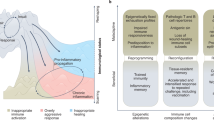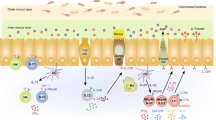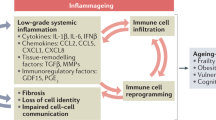Abstract
The immune systems of wild rats and of laboratory rats can been utilized as models of the human immune system in pre-industrial and post-industrial societies, respectively. In this study, lymphocyte phenotypes in wild rats were broadly characterized, and the results were compared to those obtained by us and by others using cells derived from various strains of laboratory rats. Although not expected, the production of regulatory T cells was not apparently different in wild rats compared to laboratory rats. On the other hand, differences in expression of markers involved in complement regulation, adhesion, signaling and maturation suggest increased complement regulation and decreased sensitivity in wild-caught rats compared to laboratory rats, and point toward complex differences between the maturation of T cells. The results potentially lend insight into the pathogenesis of post-industrial epidemics of allergy and autoimmune disease.
This is a preview of subscription content, access via your institution
Access options
Subscribe to this journal
Receive 12 digital issues and online access to articles
$119.00 per year
only $9.92 per issue
Buy this article
- Purchase on Springer Link
- Instant access to full article PDF
Prices may be subject to local taxes which are calculated during checkout







Similar content being viewed by others
References
Borkow G, Leng Q, Weisman Z, Stein M, Galai N, Kalinkovich A et al. Chronic immune activation associated with intestinal helminth infections results in impaired signal transduction and anergy. J Clin Invest 2000; 106: 1053–1060.
Worldwide variation in prevalence of symptoms of asthma, allergic rhinoconjunctivitis, and atopic eczema: ISAAC. The International Study of Asthma and Allergies in Childhood (ISAAC) Steering Committee.[see comment]. Lancet 2005; 351: 1225–1232.
Onkamo P, Vaananen S, Karvonen M, Tuomilehto J . Worldwide increase in incidence of Type I diabetes—the analysis of the data on published incidence trends. Diabetologia 1999; 42: 1395–1403.
Black P . Why is the prevalence of allergy and autoimmunity increasing? Trends Immunol 2001; 22: 354–355.
Gergen PJ, Turkeltaub PC, Kovar MG . The prevalence of allergic skin test reactivity to eight common aeroallergens in the U.S. population: results from the second National Health and Nutrition Examination Survey. J Allergy Clin Immunol 1987; 80: 669–679.
Maizels RM, Bundy DA, Selkirk ME, Smith DF, Anderson RM . Immunological modulation and evasion by helminth parasites in human populations. Nature 1993; 365: 797–805.
Gale EA . A missing link in the hygiene hypothesis?[see comment]. Diabetologia 2002; 45: 588–594.
Yazdanbakhsh M, Kremsner PG, van Ree R . Allergy, parasites, and the hygiene hypothesis. Science 2002; 296: 490–494.
Holt PG . Parasites, atopy, and the hygiene hypothesis: resolution of a paradox?[see comment][comment]. Lancet 2000; 356: 1699–701.
de Borst MH, de Boer RA, Stolk RP, Slaets JP, Wolffenbuttel BH, Navis G . Vitamin D deficiency: universal risk factor for multifactorial diseases? Curr Drug Targets 2011; 12: 97–106.
Bilbo SD, Wray GA, Perkins SE, Parker W . Reconstitution of the human biome as the most reasonable solution for epidemics of allergic and autoimmune diseases. Med Hypotheses 2011; 77: 494–504.
Bickler SW, DeMaio A . Western diseases: current concepts and implications for pediatric surgery research and practice. Pediatr Surg Int 2008; 24: 251–255.
Capron A, Dombrowicz D, Capron M . Helminth infections and allergic diseases. Clin Rev Allergy Immunol 2004; 26: 25–34.
Wilson MS, Maizels RM . Regulation of allergy and autoimmunity in helminth infection. Clin Rev Allergy Immunol 2004; 24: 35–50.
Fumagalli M, Pozzoli U, Cagliani R, Comi GP, Riva S, Clerici M et al. Parasites represent a major selective force for interleukin genes and shape the genetic predisposition to autoimmune conditions. J Exp Med 2009; 206: 1395–1408.
Rook GA . Review series on helminths, immune modulation and the hygiene hypothesis: the broader implications of the hygiene hypothesis. Immunology 2009; 126: 3–11.
Correale J, Farez M . Association between parasite infection and immune responses in multiple sclerosis. Ann Neurol 2007; 61: 97–108.
Summers RW, Elliott DE, Qadir K, Urban JF Jr, Thompson R, Weinstock JV . Trichuris suis seems to be safe and possibly effective in the treatment of inflammatory bowel disease.[see comment]. Am J Gastroenterol 2003; 98: 2034–2041.
Imai S, Fujita K . Molecules of parasites as immunomodulatory drugs. Curr Top Med Chem 2004; 4: 539–552.
Hewitson JP, Grainger JR, Maizels RM . Helminth immunoregulation: the role of parasite secreted proteins in modulating host immunity. Mol Biochem Parasitol 2009; 167: 1–11.
Poinar G Jr, Boucot AJ . Evidence of intestinal parasites of dinosaurs. Parasitology 2006; 133: 245–249.
Hurtado AM, Frey MA, Hill K, Baker J . The role of helminths in human evolution. Implications for global health in the 21st century. In: Elton S, O'Higgins P (ed.) Medicine and Evolution: Current Applications, Future Prospects. New York: Taylor & Francis, 2008: 153–180.
Wilson MS, Maizels RM . Regulatory T cells induced by parasites and the modulation of allergic responses. Chem Immunol Allergy 2006; 90: 176–195.
Lesher A, Li B, Whitt P, Newton N, Devalapalli AP, Shieh K et al. Increased IL-4 production and attenuated proliferative and proinflammatory responses of splenocytes from wild-caught rats (Rattus norvegicus). Immunol Cell Biol 2006; 84: 374–382.
Devalapalli AP, Lesher A, Shieh K, Solow JS, Everett ML, Edala AS et al. Increased Levels of IgE and autoreactive, polyreactive IgG in wild rodents: implications for the hygiene hypothesis. Scand J Immunol 2006; 64: 125–136.
Hewitt JK, Fulker DW, Broadhurst PL . Genetics of escape avoidance conditioning in laboratory and wild populations of rats a biometrical approach. Behav Genet 1981; 11: 533–544.
Ashwood P, Wills S, van de Water J . The immune response in autism: a new frontier for autism research. J Leukoc Biol 2006; 80: 1–15.
Becker KG . Autism, asthma, inflammation, and the hygiene hypothesis. Med Hypotheses 2007; 69: 731–740.
Vargas DL, Nascimbene C, Krishnan C, Zimmerman AW, Pardo CA . Neuroglial activation and neuroinflammation in the brain of patients with autism. Ann Neurol 2005; 57: 67–81.
Miller RG . Simultaneous Statistical Inference. 2nd ed. New York: Springer-Verlag, 1981: 6–8.
Nolte-'t Hoen EN, Boot EP, Wagenaar-Hilbers JP, van Bilsen JH, Arkesteijn GJ, Storm G et al. Identification and monitoring of effector and regulatory T cells during experimental arthritis based on differential expression of CD25 and CD134. J Leukoc Biol 2008; 83: 112–121.
Abolins SR, Pocock MJ, Hafalla JC, Riley EM, Viney ME . Measures of immune function of wild mice, Mus musculus. Mol Ecol 2011; 20: 881–892.
Monteseirin J, Llamas E, Sanchez-Monteseirin H, Bonilla I, Camacho MJ, Conde J et al. IgE-mediated downregulation of L-selectin (CD62L) on lymphocytes from asthmatic patients. Allergy 2001; 56: 164–168.
Li O, Liu JQ, Zhang H, Zheng P, Liu Y, Bai XF . CD62L is required for the priming of encephalitogenic T cells but does not play a major role in the effector phase of experimental autoimmune encephalomyelitis. Scand J Immunol 2006; 64: 117–124.
Grewal IS, Foellmer HG, Grewal KD, Wang H, Lee WP, Tumas D et al. CD62L is required on effector cells for local interactions in the CNS to cause myelin damage in experimental allergic encephalomyelitis. Immunity 2001; 14: 291–302.
Meddows-Taylor S, Kuhn L, Meyers TM, Tiemessen CT . Altered expression of L-selectin (CD62L) on polymorphonuclear neutrophils of children vertically infected with human immunodeficiency virus type 1. J Clin Immunol 2001; 21: 286–292.
Schleiffenbaum B, Spertini O, Tedder TF . Soluble L-selectin is present in human plasma at high levels and retains functional activity. J Cell Biol 1992; 119: 229–238.
Hanna SM, Spiller OB, Linton SM, Mead RJ, Morgan BP . Rat T cells express neither CD55 nor CD59 and are dependent on Crry for protection from homologous complement. Eur J Immunol 2002; 32: 502–509.
Friese MA, Jones EY, Fugger L . MHC II molecules in inflammatory diseases: interplay of qualities and quantities. Trends Immunol 2005; 26: 559–561.
de Bara R, Kusuda M, Caspers-Velu L, Sanui H, Chan CC, Kuwabara T et al. Cryopexy enhances experimental autoimmune uveoretinitis (EAU) in rats. Invest Ophthalmol Vis Sci 1989; 30: 2165–2173.
Jimenez E, Sacedon R, Vicente A, Hernandez-Lopez C, Zapata AG, Varas A . Rat peripheral CD4+CD8+ T lymphocytes are partially immunocompetent thymus-derived cells that undergo post-thymic maturation to become functionally mature CD4+ T lymphocytes. J Immunol 2002; 168: 5005–5013.
Yang CP, Bell EB . Functional maturation of recent thymic emigrants in the periphery: development of alloreactivity correlates with the cyclic expression of CD45RC isoforms. Eur J Immunol 1992; 22: 2261–2269.
Acton RT, Morris RJ, Williams AF . Estimation of the amount and tissue distribution of rat Thy-1.1 antigen. Eur J Immunol 1974; 4: 598–602.
Takacs L, Osawa H, Toro I, Diamantstein T . Immunohistochemical localization of cells reacting with monoclonal antibodies directed against the interleukin-2 receptor of murine, rat and human origin. Clin Exp Immunol 1985; 59: 37–44.
Takacs L, Ruscetti FW, Kovacs EJ, Rocha B, Brocke S, Diamantstein T et al. Immature, double negative (CD4−,CD8−) rat thymocytes do not express IL-2 receptors. J Immunol 1988; 141: 3810–3818.
Deng J, Dekruyff RH, Freeman GJ, Umetsu DT, Levy S . Critical role of CD81 in cognate T–B cell interactions leading to Th2 responses. Int Immunol 2002; 14: 513–523.
Shoham T, Rajapaksa R, Boucheix C, Rubinstein E, Poe JC, Tedder TF et al. The tetraspanin CD81 regulates the expression of CD19 during B cell development in a postendoplasmic reticulum compartment. J Immunol 2003; 171: 4062–4072.
Maecker HT, Do MS, Levy S . CD81 on B cells promotes interleukin 4 secretion and antibody production during T helper type 2 immune responses. Proc Natl Acad Sci USA 1998; 95: 2458–2462.
Nakagawa S, Arai Y, Mori H, Matsushita Y, Kubo T, Nakanishi T . Small interfering RNA targeting CD81 ameliorated arthritis in rats. Biochem Biophys Res Commun 2009; 388: 467–472.
Dijkstra S, Kooij G, Verbeek R, van der Pol SMA, Amor S, Geisert EE Jr et al. Targeting the tetraspanin CD81 blocks monocyte transmigration and ameliorates EAE. Neurobiol Dis 2008; 31: 413–421.
Maecker HT, Todd SC, Kim EC, Levy S . Differential expression of murine CD81 highlighted by new anti-mouse CD81 monoclonal antibodies. Hybridoma 2000; 19: 15–22.
Nagafuchi H, Shimoyama Y, Kashiwakura J, Takeno M, Sakane T, Suzuki N . Preferential expression of B7.2 (CD86), but not B7.1 (CD80), on B cells induced by CD40/CD40L interaction is essential for anti-DNA autoantibody production in patients with systemic lupus erythematosus. Clin Exp Rheumatol 2003; 21: 71–77.
Folzenlogen D, Hofer MF, Leung DY, Freed JH, Newell MK . Analysis of CD80 and CD86 expression on peripheral blood B lymphocytes reveals increased expression of CD86 in lupus patients. Clin Immunol Immunopathol 1997; 83: 199–204.
Podojil JR, Sanders VM . CD86 and beta2-adrenergic receptor stimulation regulate B-cell activity cooperatively. Trends Immunol 2005; 26: 180–185.
Kasprowicz DJ, Kohm AP, Berton MT, Chruscinski AJ, Sharpe A, Sanders VM . Stimulation of the B cell receptor, CD86 (B7-2), and the beta 2-adrenergic receptor intrinsically modulates the level of IgG1 and IgE produced per B cell. J Immunol 2000; 165: 680–690.
Webster JP, Macdonald DW . Parasites of wild brown rats (Rattus norvegicus) on UK farms. Parasitology 1995; 111: 247–255.
Easterbrook JD, Kaplan JB, Glass GE, Watson J, Klein SL . A survey of rodent-borne pathogens carried by wild-caught Norway rats: a potential threat to laboratory rodent colonies. Lab Anim 2008; 42: 92–98.
Ogilvie BM, Askenase PW, Rose E . Basophils and eosinophils in 3 strains of rats and in athymic nude rats following infection with the nematodes Nippostrongylus brasiliensis or Trichinella spiralis. Immunology 1980; 39: 385–90.
Baker DG . Natural pathogens of laboratory mice, rats, and rabbits and their effects on research. Clin Microbiol Rev 1998; 11: 231–266.
Perec-Matysiak A, Okulewicz A, Hildebrand J, Zalesny G . Helminth parasites of laboratory mice and rats. Wiad Parazytol 2006; 52: 99–102.
Matalka KZ . Neuroendocrine and cytokines-induced responses to minutes, hours, and days of mental stress. Neuroendocrinol Lett 2003; 24: 283–292.
Reiche EM, Nunes SO, Morimoto HK . Stress, depression, the immune system, and cancer. Lancet Oncol 2004; 5: 617–625.
Stojanovich L, Marisavljevich D . Stress as a trigger of autoimmune disease. Autoimmun Rev 2008; 7: 209–213.
Os'kina IN, Shikhevich SG, Karyagina AY, Gulevich RG . Humoral immune response in norway rats selected for behavior. Dokl Biol Sci 2001; 378: 277–279.
Lafferty KD . Microbiology. Interacting parasites. Science 2010; 330: 187–188.
Curry AJ, Else KJ, Jones F, Bancroft A, Grencis RK, Dunne DW . Evidence that cytokine-mediated immune interactions induced by Schistosoma mansoni alter disease outcome in mice concurrently infected with Trichuris muris. J Exp Med 1995; 181: 769–774.
Graham AL . Ecological rules governing helminth–microparasite coinfection. Proc Natl Acad Sci USA 2008; 105: 566–570.
Wellicome SM, Kapahi P, Mason JC, Lebranchu Y, Yarwood H, Haskard DO . Detection of a circulating form of vascular cell adhesion molecule-1: raised levels in rheumatoid arthritis and systemic lupus erythematosus. Clin Exp Immunol 1993; 92: 412–418.
van Den Engel NK, Heidenthal E, Vinke A, Kolb H, Martin S . Circulating forms of intercellular adhesion molecule (ICAM)-1 in mice lacking membranous ICAM-1. Blood 2000; 95: 1350–1355.
Martin S, Rieckmann P, Melchers I, Wagner R, Bertrams J, Voskuyl AE et al. Circulating forms of ICAM-3 (cICAM-3). Elevated levels in autoimmune diseases and lack of association with cICAM-1. J Immunol 1995; 154: 1951–1955.
Hamzaoui A, Hamzaoui K, Kahan A, Chabbou A . Levels of soluble VCAM-1, soluble ICAM-1 and soluble E-selectin in patients with tuberculous pleuritis. Mediat Inflamm 1996; 5: 276–279.
Koraka P, Murgue B, Deparis X, van Gorp EC, Setiati TE, Osterhaus AD et al. Elevation of soluble VCAM-1 plasma levels in children with acute dengue virus infection of varying severity. J Med Virol 2004; 72: 445–450.
Davis MM . A prescription for human immunology. Immunity 2008; 29: 835–838.
Acknowledgements
This work was supported in part by award AI-51445 (Duke Human Vaccine Institute Flow Cytometry Core Facility).
Author information
Authors and Affiliations
Corresponding author
Rights and permissions
About this article
Cite this article
Trama, A., Holzknecht, Z., Thomas, A. et al. Lymphocyte phenotypes in wild-caught rats suggest potential mechanisms underlying increased immune sensitivity in post-industrial environments. Cell Mol Immunol 9, 163–174 (2012). https://doi.org/10.1038/cmi.2011.61
Received:
Revised:
Accepted:
Published:
Issue Date:
DOI: https://doi.org/10.1038/cmi.2011.61
Keywords
This article is cited by
-
Adaptation to low parasite abundance affects immune investment and immunopathological responses of cavefish
Nature Ecology & Evolution (2020)
-
Changing expression of vertebrate immunity genes in an anthropogenic environment: a controlled experiment
BMC Evolutionary Biology (2016)



